
NCERT Solutions for Class 11 Biology chapter 5 Morphology of Flowering Plant PDF
Hey, are you a class 11 student and looking for ways to download NCERT Solutions for Class 11 Biology chapter 5 Morphology of Flowering Plant PDF? If yes. Then read this post till the end.In this article, we have listed NCERT Solutions for Class 11 Biology chapter 5 Morphology of Flowering Plant in PDF that are prepared by Kota’s top Doctor’s Faculties by keeping Simplicity in mind.
If you want to learn and understand class 11 Biology chapter 5 "Morphology of Flowering Plant" in an easy way then you can use these solutions PDF.
NCERT Solutions helps students to Practice important concepts of subjects easily. Class 11 Biology solutions provide detailed explanations of all the NCERT questions that students can use to clear their doubts instantly.
If you want to score high in your class 11 Biology Exam then it is very important for you to have a good knowledge of all the important topics, so to learn and practice those topics you can use eSaral NCERT Solutions.
In this article, we have listed NCERT Solutions for Class 11 Biology chapter 5 Morphology of Flowering Plant PDF that you can download to start your preparations anytime.
So, without wasting more time Let’s start.
Download NCERT Solutions for Class 11 Biology chapter 5 Morphology of Flowering Plant PDF
Question 1. What is meant by modification of root? What type of modification of root is found in the:
(a) Banyan tree (b) Turnip (c) Mangrove trees
Solution: When roots of certain plants change its form, origin and role in order to perform functions such as storage of food, support and respiration it is refer to as modification of roots.
-They arise from the different parts of the plant, and such types of the root are referred to as the "adventitious roots."
Root modification found in the following plants:
(a) Banyan tree: In Banyan tree roots are referred to as "prop roots." They arise from the stem and reaches to the ground; the primary purpose of these roots is to provide support to the plant as it grows.
(b) Turnip: In turnip, the taproot of the plant gets modifies to store food. A similar type of modification is present other plants such as carrot, radish, and adventitious root of sweet potato.
(c) Mangroves trees:- Mangroves trees (Rhizophora) grows in the marshy and swampy area due to these roots are unable to perform respiration.
-Roots of these plants come out from the ground and grow vertically upwards to absorb oxygen for respiration, such types of modified roots are known as "pneumatophores."
Question 2. Justify the following statements on the basis of external features:
(i) Underground parts of a plant are not always roots.
(ii) Flower is a modified shoot.
Solution: (i) Underground parts of a plant are not always roots.
-In certain plants such as potato, ginger turmeric, zamikand, colocasia, stems grow underground to perform the function of food storage and vegetative propagation.
-Underground stem serves as the organ of perennation and prevents the plant from the unfavorable condition.
(ii) Flower is a modified shoot.
The apical meristem of stem gets modified into floral meristem a and starts bearing flower then it is referred to as the modification of shoot into the flower.
The changes happen during modification are:
-The elongation of internodes stops.
- Condensation of the axis takes place.
- Position of the leaves on apex and nodes is replaced by floral meristem.
- Formation of floral appendages takes place on the apex and the on nodes in the lateral direction.
Question 3. How is a pinnately compound leaf different from a palmately compound leaf?
Solution: -Pinnately compound leaf and palmately compound leaf are the modification of compound leaf.
-Following are the differences between pinnately compound leaf and palmately compound leaf

Diagram showing pinnately compound leaves and palmately compound leaf.
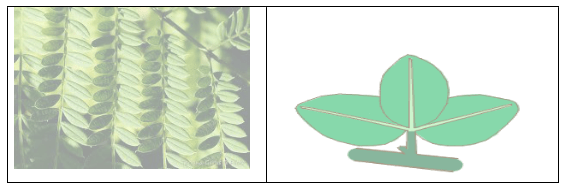
Question 4. Explain with suitable examples of the different types of phyllotaxy.
Solution: -Phyllotaxy refers to the pattern in which leaves are arranged on the stem or branch.
-There are three types of arrangement are as follows
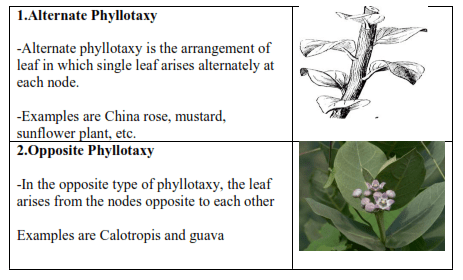

Question 5. Define the following terms: (2marks each definition)
(a) aestivation
(b) placentation
(c) actinomorphic
(d) zygomorphic
(e) superior ovary
(f) perigynous flower
(g) epipetalous stamen
Solution: (a) Aestivation :
Aestivation refers to the mode of arrangement of sepals and petal in the floral bud in comparison to the other members of the same whorl.
There are five types of aestivation found in Corolla:
- Valvate in Calotropis
- Twisted in China rose lady finger and cotton
- Imbricate in Casia and Gulmohur
- Vexillary in pea and bean flowers
(b) Placentation:
Placentation refers to the pattern in which ovules are arranged in the ovary.
- Types of placentation are as follows:
-Marginal in peas
-Axile in China rose tomato and lemon
-Parietal in mustard and argemone
-Free central in Dianthus and Primrose
-Basal in sunflower and mustard
(c) Actinomorphic
-When the symmetry of a flower is radial, that is when it can be divided into two radial halves in a radial plane passing through the center, then it referred to as the
"Actinomorphic flower."
-Examples of Actinomorphic flower are:
-Mustad, Chilli, Dhatura
It is represented by the symbol $\oplus$ when explained in floral formula and diagram.
(d) Zygomorphic:
-When the symmetry of the flower is bilateral, which means when the flower is divided into two half, each half is the mirror image of another half then it is referred to as the
"Zygomorphic flower."
- Examples of the zygomorphic flower are a pea, gulmohur, bean, and cassia
- It is represented by the symbol \% when explained in floral formula and diagram.
(e) Superior ovary:
-When the gynoecium occupies the highest position while the other parts are situated below as the ovary also occupies the highest position are referred to as the superior ovary.
- Flowers in which superior ovary is present are known as hypogynous flowers.
-Examples are mustard, China rose, and brinjal.
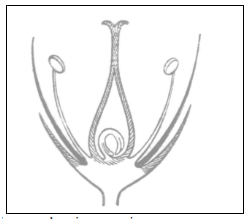
Diagram showing superior ovary
(f) Perigynous Flower:
-Flower in which gynoecium is present at the center and other parts of the flower such as calyx corolla and androecium are present at the edge of the thalamus then it is known as a perigynous flower.
-Examples of plant having perigynous flower are plum, rose, and peach.
Diagram showing perigynous flower
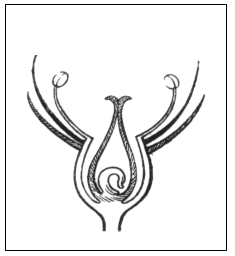
(g) Epipetalous stamen:
In certain plants where stamen (androecium) is attached to the petals, such type of conditions are referred to as epipetalous stamen.
- Example of flower having epipetalous stamen is brinjal.
Question 6. Differentiate between
(a) Racemose and cymose inflorescence
(b) Fibrous root and adventitious root
(c) Apocarpous and syncarpous ovary
Solution: (a) Racemose and cymose inflorescence
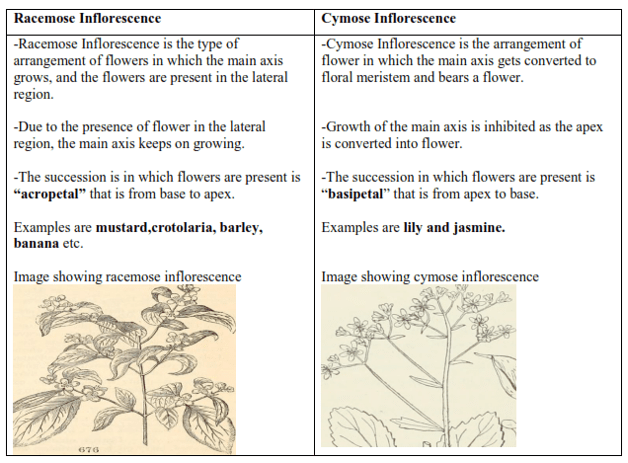
(b) Fibrous root and adventitious root
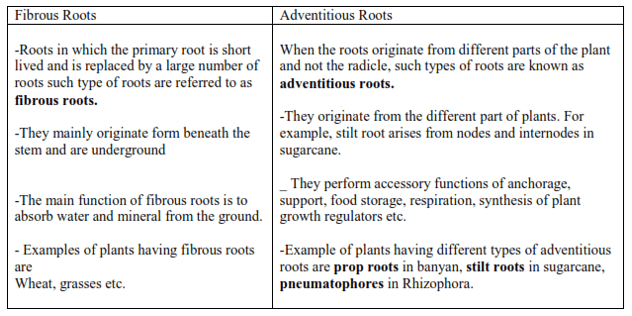

Apocarpous and syncarpous ovary

Question 7. Draw the labelled diagram of the following:
(i) gram seed
(ii) V.S. of maize seed
Solution: Diagram showing gram seeds

Diagram showing V.S. of maize seeds.

Question 8. Describe modifications of stem with suitable examples
Sôlution: When stem changes its form origin and shape to perform functions such as storage, protection, vegetative propagation, it is then referred to as the modified stem.
Modification in stem and function performed by them are as follows:
Food storage stems-
In certain plants such as the roots perform the function of storage of food. The storage roots also serve as the organ of perennation in order to prevent the plant from the unfavorable condition.
Examples of food storage stems are potato, ginger, turmeric, zaminkand, colocasia etc.
-Stem Tendrils for support-
Tendrils are the modification of axillary, but they are slender and spirally coiled.
-They help the plant to climb along with the support.
-Examples of the plants having stem tendrils are gourds such as cucumber, pumpkins, watermelon and grapevines.
-Thorns for protection:-
-When the axillary bud gets modified into a woody, a straight prickly and pointed structure such types of modification in the stem is referred to as thorns. The function of such modification is to prevent the plant from getting consumed by animals.
-Examples of plants having thorns are Citrus, Bougainvillea.
Water storage stems-(1 marks for correct description and example)
- Certain plants that grow in the arid region in such types of plants stem gets flattened or turns fleshy cylindrical in order to store water.
Examples are Euphorbia and opuntia
-Stems for vegetative propogation:-
- In certain plants stems get buried and spread underground, when the old part of the plant dies it leads to the formation of the new plant.
-Examples are grass and strawberry.
-In certain plants, the soft and slender lateral branches that arise from the main branch. After growing for a certain time, it gets buried underground and starts bearing roots for absorbing water after some time the lateral branch serves as the main plant. Examples are mint and jasmine
-In aquatic plants, the node and internode bear the tuft of roots. Examples are Pistia and Eichhornia
-Lateral stems of plants originate from the main axis grows beneath the soil, comes vertically upwards and further bears leaves.
- Example are pineapple, banana and chrysanthemum
Question 9. Take one flower each of the families Fabaceae and Solanaceae and write its semi-technical description. Also, draw their floral diagram after studying them.
Flower of the family Fabaceae

Technical description for Fabaceae:
Fabaceae family was earlier known as Papilionoideae
Fabaceae is the sub family of family Leguminosae
Vegetative characters of the sub-famliy are as follows:
Stem: The stem is erect and is mainly a climber.
Leaves: Phyllotaxy is alternate; they can be pinnately compound or simple compound.
-Leaf base is pulvinate and has stipule.
-Venetion is reticulate.
Floral
character
s of the
family
Fabacae
Inflorescence: Arrangement of the flower is racemose that is plant bear flowers on the lateral region.
Flower type -Flower is bisexual and bilaterally symmetrical known as "zygomorphic".
Calyx:
-Sepals are five and are fused, which means gamosepalous.
-Aestivation of sepals is either valvate or imbricate.
Corolla:-
-Petals are five in number that is polypetalous, consisting of a posterior standard, two lateral wings, two anterior ones forming a keel (enclosing stamens and pistil),
Aestivation is vexillary
Androecium:
-Stamens are ten in number and are diadelphous ( 9 fused and 1 free)
-Anther has two layers and is known as dithecous
Gynoecium:
-Ovary is superior
-It has single carpel mono carpellary, unilocular with many ovules, and style is single
Fruit: It is mainly legume; seeds in fruit can be one to many. The endosperm is absent hence non-endospermic
Floral Formula: (1 marks for correct formulae)
$\% \mathrm{~K}_{(5)} \mathrm{C}_{1+2+(2)} \mathrm{A}_{(9)+1}$
$\mathrm{G}_{1}$
Floral Diagram
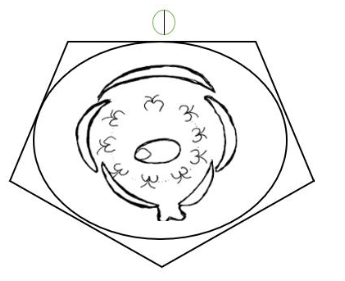
Examples and economic
Importance
-Pulses, which includes gram arhar moong soyabean, are consumed as the protein source. - Soya bean and groundnut provides edible oil.
-Indigofera provides dye.
-SunHemp provides fiber.
-Sesbania and trifolium are the sources of fodder.
-Mulathi has medicinal properties.
-Ornamental plants are lupin and sweet pea.
Flower of Family Solanacae

The technical description is as follows:
Family Solanacae is large and is known as 'potato family'.
Its distribution is in tropics, subtropics and even temperate zones.
Vegetative characters of family Solanacae are as follows:
Plants include herbs, shrubs and small trees.
Stem:
-The stem is herbaceous, rarely woody, aerial; erect, cylindrical, branched, solid or hollow, hairy or glabrous,
-The stem is underground in potato (Solanum tuberosum)
Leaves:
-Phyllotaxy is alternate. Leaves are simple, pinnately compound and exstipulate.
-Venation in leaves is reticulate.
Floral Characters of family Solanacae are:
Inflorescence : Arrangement of the flower is cymose.
Flower:
The flower is bisexual and symmetry is radial type known as actinomorphic
Calyx:
-Sepals are five in number and are united.
- Aestivation of sepals is valvate
Corolla:
- Petals are five in number, and they are united.
-Aestivation of petals is valvate
Androecium:
Stamens are five and are epipetalous.
Gynoecium:
The gynoecium is bicarpellary, and carpels are fused known as syncarpous;
The ovary is superior and bilocular.
The placenta is swollen with many ovules.
Fruits: Fruit type is berry or capsule.
Seeds: Seeds are multiple and contain endosperm.
Floral Formula: (1 marks for correct formulae)
$\oplus_{+}^{*} \mathrm{~K}_{(5)} \widehat{\mathrm{C}_{(5)}} \mathrm{A}_{5} \underline{\mathrm{G}}_{(2)}$
Floral Diagram:
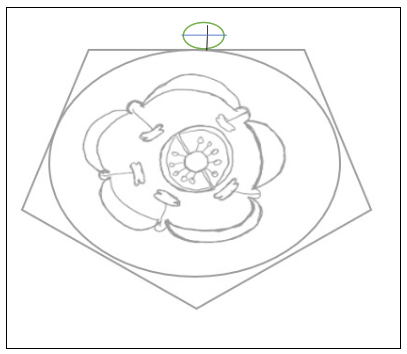
Examples with economic importance:
They serve as sources of food in tomato, brinjal, potato
They are spices such as chilly
Plants for medicinal importance are belladonna and ashwagandha
They serve the fumigatory purpose in tobacco
They are used for ornamental purposes in petunia.
Question 10. Describe the various types of placentations found in flowering plants.
Solution. Placentation refers to the pattern in which ovules are arranged in the ovary.
-Types of placentation are as follows:
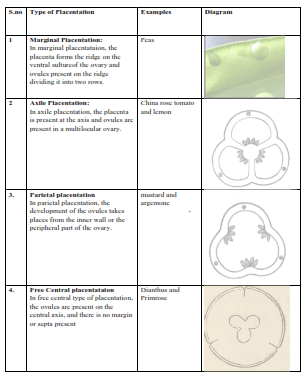

Question 11. What is a flower? Describe the parts of a typical angiosperm flower.
Solution. When the apical meristem of the shoot takes responsibility for sexual reproduction, then it gets converted to floral meristem then it gives rise to flower in angiosperms. (1 mark for explaining flower)
-A flower is formed when elongation of internodes stops, and condensation of the main axis takes place finally the position of the leaves on apex and nodes is replaced by the floral meristem.
If the flower is inverted, then it has four whorls from outside to inside they are calyx (sepals), corolla (petals), androecium and gynoecium.
Calyx and corolla are the accessory organs, whereas androecium and gynoecium are the reproductive organs.
In certain plants, the calyx and corolla are fused; this condition is known as perianth.
Sarts of the flowers are as follows:
i. Calyx: The outermost part of the flower and the lowermost whorl is refer as the calyx.
-The calyx is also called as sepals which are green in color and shape is leaf like.
- The major function of sepal's protection of flower in the bud stage and protection of reproductive structures of the flower.
ii. Corolla: Corolla is also referred to as petals and forms the second whorl of the flower that is present inside the sepals and outside the stamens. Corolla is the brightest and colored part of the flower, and its shape is flat and leaf like. The corolla can be fused or united and also possess scent. The main function of the corolla is to attract pollinators for pollination.
iii. Androecium: The androecium refers to the male reproductive part pf the plant. Parts of the stamens are anther and filament. The anther is di- thecous that is it has two layers and is a bilobed structure each lobe has two chambers known as pollen sacs. The pollen sacs carry out the production of pollen grains and stores it till dehiscence.
iv. Gynoecium: The innermost whorl of the flower is the female reproductive part known as gynoecium.
-It is referred to as carpel or pistil. Carpel consists of three main parts, which are stigma, style and ovary.
-Stigma is the region which receives the pollen grains, and style connects stamen to the ovary. The basal part of the the gynoecium is ovary each ovary contains one to many ovules attached to a flat cushion like structure placenta. Male gamete in the pollen grain fuse egg cell present in ovary later ovary develops into fruit and ovule into seeds
-Carpels are referred to apocarpous if there are multiple free carpels for examples lily and rose and it is referring to as syncarpous when it is fused and is single, for example, mustard and tomato.
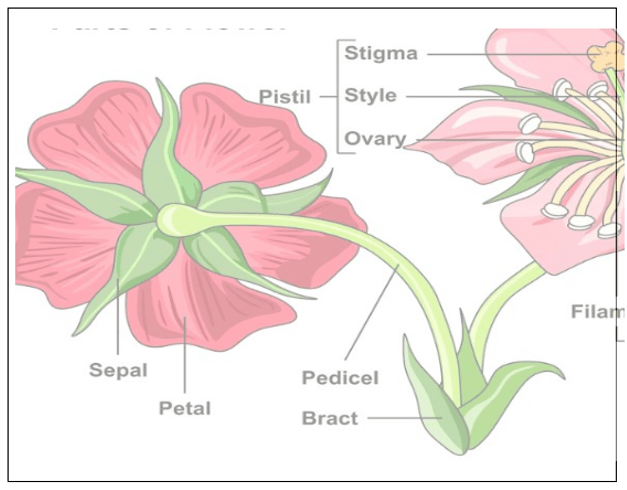
Diagram showing different parts of the flower
Question 12. How do the various leaf modifications help plants?
Solution. The primary function of the leaves is to perform photosynthesis, but they undergo modification in order to support the plant for various other purposes such as:
1. Tendril for support: Leaves in certain plants get converted into the spirally coiled structure in order to support the plant. Example is pea plant.
2. Spines for protection: In certain xerophytic plants the leaves are modified into spines in order to prevent water loss through transpiration and preventing the plant from getting browsed by the animals. Examples are opuntia and Euphorbia.
3. Fleshy leaves for storage: Leaves becomes fleshy a swollen and stores food in the form of carbohydrates. Examples are onion and garlic
4. Nutrient deriving leaves: Leaves of certain insectivorous plants gets modified in order to obtain nitrogen from insects, examples are pitcher plant, Venus-fly trap .
Question 13. Define the term inflorescence. Explain the basis for the different types of inflorescence in flowering plants Inflorescence is reffered to as the arrangement of flowers on the stem.
Solution: Defination:- Inflorescence referred to as the arrangement or the pattern of the flowers on the floral axis.
The inflorescence is of two types:
i. Racemose inflorescence: In the racemose type of inflorescence, the later branch bears flowers in a pattern where old flowers are at the base and new flowers at the top. The main axis does not get converted into a floral axis and continues to grow. The succession in flowers grows from top to bottom is known as acropetal succession.
ii. Cymose inflorescence: In the cymose type of inflorescence, the main axis bears flower hence limiting the growth of the main axis. The flowers are arranged in such a manner in which old flower is present at the apex and young flower at the base, such type of succession is known as basipetal succession.
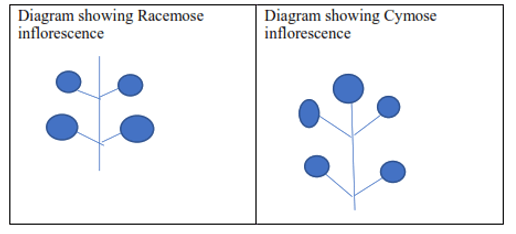
Question 14. Write the floral formula of the actinomorphic, bisexual, hypogynous flower with five united sepals, five free petals, five free stamens and two united carpleswith the superior ovary and axile placentation.
Solution. The description is given for the floral formulae for family Solanaceae

Question 15. Describe the arrangement of floral members in relation to their insertion on thalamus.
Solution: Based on the position of calyx, corolla and androecium in respect of the ovary on the thalamus, the flowers are of three types:
Hypogynous Flower:
In hypogynous flower, the carpel is present at the highest position, and other parts such as calyx corolla and androecium are present below it, such types of flowers are referred to as hypogynous.
The ovary in flowers is said to be a superior ovary.
Examples are mustard, china rose and brinjal.
Diagram showing hypogynous flower

Perigynous flower
In perigynous flower, the gynoecium is situated in the centre, and other parts of the flower are located on the rim of the thalamus almost at the same level, it is called perigynous.
The ovary in such type of flower is known as half inferior, examples are plum rose, peach.
Diagram showing perigynous flower

Epigynous flower: ( 1 mark for correct explanation and $0.5,0.5$ marks for the position of ovary and example)
In epigynous flowers, the margin of thalamus grows upward enclosing the ovary completely and getting fused with it, the other parts of flower arise above the ovary.
The position of ovary in such type of plant is said to be inferior.
Example of flowers is guava and cucumber, and the ray florets of sunflower.
Diagram showing Epigynous flower

Also Read,
Class 11 Chemistry Notes free PDF Download.
Class 11 Biology Book Chapterwise free PDF Download.
Class 11 Biology Exemplar Chapterwise free PDF Download.
If you have any Confusion related to NCERT Solutions for Class 11 Biology chapter 5 Morphology of Flowering Plant PDF then feel free to ask in the comments section down below.
To watch Free Learning Videos on Class 11 Biology by Kota’s top Doctor’s Faculties Install the eSaral App
